Trucking Technology Connects the Dots for Carriers
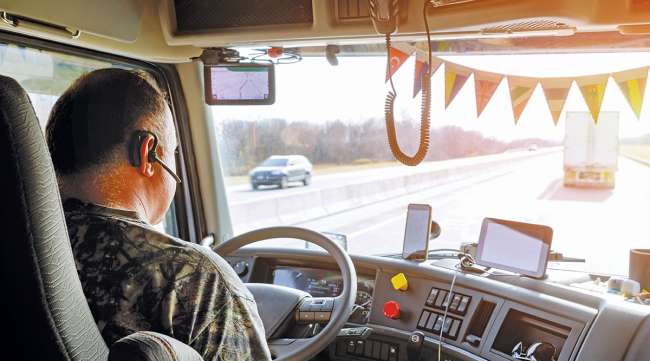
[Stay on top of transportation news: Get TTNews in your inbox.]
As connected trucks rack up miles and pile up data, fleet managers can increasingly make use of the Internet of Things and artificial intelligence to access and act on the incoming information, telematics vendors and trucking executives said.
Connected fleet technologies that generate data include vehicle tracking, electronic logging devices, driver performance monitoring systems, dashboard cameras, tire monitoring and inflation systems, and drivers’ smartphones and tablets.
In recent years, onboard video systems have become increasingly common in the trucking industry.
“Dashcam video is electronic gold to us,” said Ryan Domengeaux, chief legal officer for United Vision Logistics.
RELATED: Connected Trucks Go Mainstream
The Lafayette, La.-based company has some 1,200 contracted owner-operators using a dashcam provided by Motive. The connectivity provided by the technology enables the company to begin addressing accidents within minutes, Domengeaux said.
“I’ll get a notification on my phone via text message to tell me that a collision has occurred — and that can be a collision with an alligator in the middle of the road or it could be an incident with another vehicle,” he said.
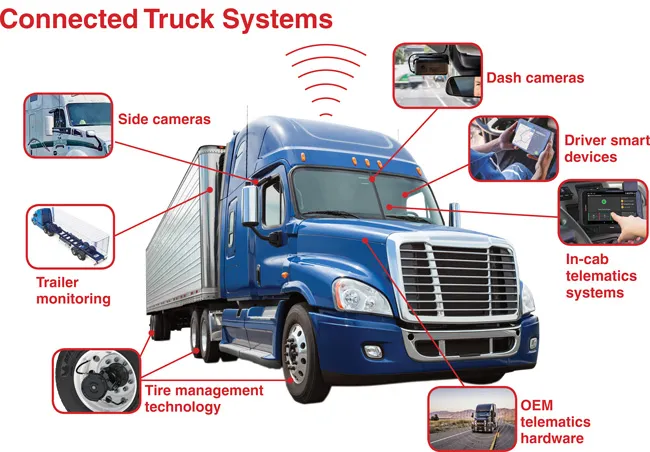
(Samsara, Trimble, Orbcomm, Mack Trucks, Aperia Technologies, Drov Technologies, Isaac Instruments via Facebook; graphic by Transport Topics)
The text is followed by an email notification with a link to video.
“I can see immediately what occurred,” Domengeaux said.
UVL provides Motive’s dashcams under a leasing agreement with drivers. The device can issue a speeding alert — an audio signal to the driver.
“That seemed to redirect the behaviors,” Domengeaux said, adding that speeding events dropped by 75% in the months after the devices were installed.
A forward collision warning system developed by Motive also is undergoing testing with all of UVL’s units, Domengeaux said.

Domengeaux
“If there is any downside to this technological advancement, it’s that there is so much information available,” he said.
UVL enlisted outside analysts to dig into claims data, hours-of-service data from ELDs and driving data from dashcam video, Domengeaux said.
Stewart Transport, a refrigerated carrier based in Phoenix, is using an integrated telematics system called Driver•i One, which combines Netradyne’s video-based safety technology with Geotab’s fleet management capabilities on the same device.
“I can pull up a driver’s logs [using Geotab] and see what he’s doing and then immediately click over to Netradyne” to look for corresponding video footage, said Amanda Gallegos, director of risk management at Stewart Transport.
“It integrates really nicely,” said Gallegos, who previously had to access multiple portals for that information.
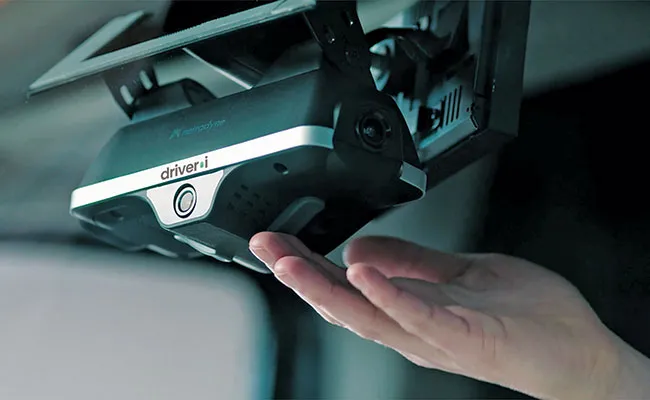
Onboard camera systems that record the truck’s surroundings and detect distracted
driving and other unsafe practices, such as Netradyne's Driver•i One, have become increasingly common in trucking. (Netradyne)
Netradyne said its integration with Geotab provides in-cab video along with forward-facing and side views, data on driving behaviors, GPS tracking, HOS reporting, maintenance and fuel management.
Stewart Transport operates a fleet of about 160 tractors and 180 temperature-controlled trailers. Gallegos recalled that there were cameras in the trucks when she started with the carrier 14 years ago, but if a crash occurred, the video was not available immediately.
“The driver had to come all the way back to Phoenix,” she said. “I had to take the SD card out [and] download it. Obviously now it’s completely different.”
With Netradyne, Stewart Transport opted to install four cameras on each truck: facing forward, facing the driver, pointing toward the driver’s side and pointing toward the passenger’s side.
“That’s a lot of data,” Gallegos said.
The carrier decided to focus on distracted driving, speeding and following distance “because we knew — based on our data — that those are the ones that could be catastrophic or [involve] liability.”
AI is making it easier for fleets to sift through all that information, but the human touch is still required.
“I love AI because it finds the smallest detail in a driver’s behavior. But AI is AI,” Gallegos said. “Maybe our driver is holding a pen in his hand, or maybe he’s taking a drink. AI tags it as distracted.”

Gallegos
To identify and prioritize the most important clips, Stewart Transport has a full-time employee on staff to review the videos.
“About 80% of her job is going through all the AI tags,” Gallegos said.
Stewart Transport conducts an annual safety campaign based on the nature of the AI alerts generated the prior year. These safety campaigns are “constantly evolving,” Gallegos said. “They change based on the data, which we get from Netradyne and their AI reports.”
One element of Stewart Transport’s safety campaigns is a monthly audio podcast issued to drivers on Storyboard, a mobile phone app.
The podcast discusses the latest number and types of AI alerts that the company experienced.
RELATED: AI, Edge Computing Are Shaping the Future of Fleet Telematics
“We talk about how many distracted driving issues we had,” Gallegos said. “And we hear the drivers [when] they say it’s really hard to get space cushioning in [a certain] county because the traffic is so bad. What can we do to help that situation?”
Listening to the monthly podcast is part of how drivers qualify for a safety bonus. The app tracks when drivers listen, how long they listen and if they listen more than once, Gallegos said.
Connected Operations
Connectivity has improved in recent years in large part because of the expanded availability of 4G and 5G wireless technology, telematics vendors said.
Uploading videos is much more cost effective on today’s networks, which has made AI dashcams more affordable, said Abhishek Gupta, vice president of product at Motive.

Gupta
“We will see more powerful computer vision chips coming online,” which will improve AI dashcams, Gupta added.
Computer vision, a form of AI, employs cameras, data and algorithms to train a machine or device, such as a dashcam, to recognize and react to other vehicles on the road.
Paul Cardosi, sector vice president of global mobility at Trimble, said connected fleet technology has progressed significantly in the past 10-15 years, which has helped the transportation industry address inefficiencies.
At the same time, trucking companies are being pushed by shippers to change how they operate, Cardosi said. Connectivity of mobile devices used by drivers — whether they are in or out of their cabs — can help carriers meet shippers’ rising expectations, he said.
“We know drivers drive, but the driver also does a lot outside the cab of the truck,” Cardosi said.
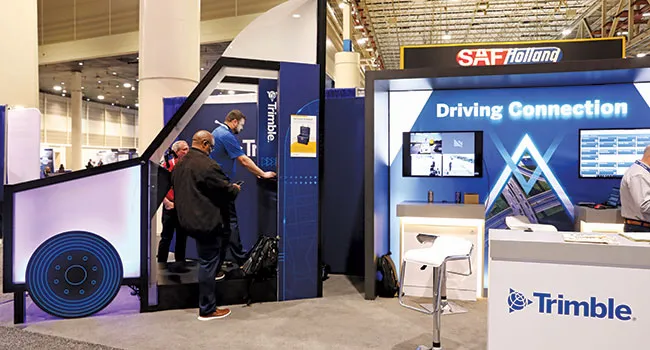
Trimble showcases its trucking technology offerings at a recent industry trade show. (John Sommers II for Transport Topics)
The growth of connected vehicle technology is just one aspect of the expansion of the Internet of Things across many other industries and society as a whole.
“IoT is a fancy way of saying there are different data feeds” from a variety of sensors, said John Elsner, CEO of Pedigree Technologies, which markets a fleet management system called OneView. “Telematics is really a subset of IoT.”
Pedigree’s telematics system and those of other vendors pull data from multiple sources, including trucks and engines.
Technology Convergence
Some technology vendors are aiming to provide “one pane of glass” or “all in one” technology packages to support fleets in multiple facets of their operations.
“We’re connecting those point solutions under a single unified platform,” said Grant Gardner, a senior vice president at Solera, the parent of several transportation technology brands, including Omnitracs.
Gardner pointed out trends in trucking and in telematics, each spurring the other.
Transtex CEO Mathieu Boivin discusses the environmental sustainability of auxiliary power units. Tune in above or by going to RoadSigns.ttnews.com.
“You see companies moving to wider integrated delivery models,” Gardner said, citing how a less-than-truckload carrier might move into last-mile delivery to support e-commerce demand, and vice versa.
At the same time, the form factor of tech devices is becoming “more stealth, smaller, and, in some cases, less expensive,” Gardner said.
“Once the focus was in-cab and ELD,” he said. “We see fleet operators looking to combine these solutions. Now they’re looking at connecting all these devices to the ecosystem through a centralized platform.”
Similarly, Gupta said Motive is now “an integrated operations platform that focuses on a single pane of glass.”
The company’s target customers, including motor carriers, “care about all-in-one solutions,” he said.
Jonathan Bates, chief product officer at Powerfleet, observed that many trucking companies work with many vendors and use many different types of software and systems.

Bates
“Their operations team is looking at different information from their C-suite team, and that’s where a lot of that data indigestion comes from,” he said. “The most important point is really the necessity of our industry to provide [a] holistic data experience. It’s less about providing the device.”
The promise of AI extends to making that whole data experience more straightforward and much more standardized, Bates said, so that trucking companies are not obliged to rely on numerous different vendors requiring numerous different software logins for different data feeds.
Cardosi of Trimble said the vendor’s Trimble Identity or Trimble ID is an identity management system allowing a user to sign on once to access multiple applications. Trimble ID also enables data-sharing among applications, he added.
Some large shippers have an application that they want the driver to complete. Drivers using the Trimble sign-on can access their data “and pull that into the shipper application,” Cardosi said.
The Rise of AI
Advances in AI and machine learning promise to enhance predictive analytics in the transportation industry, several telematics executives said.
Machine learning applies specific procedures, or algorithms, to data to imitate the way humans learn. As it receives and processes more data, machine learning recognizes repeated patterns and exceptions, improving the accuracy of AI.
Netradyne has collected data on 15 billion miles of driving to date.

Young
As a result, “the AI has become really, really intelligent and increasingly accurate,” said Netradyne’s chief marketing officer, Barrett Young.
He also said that “edge computing” benefits carriers “because it enables data to be processed and alerts to be issued in real time on the in-cab device, versus having to send [data] up to the cloud and then being processed in the cloud or perhaps being processed and analyzed by human review.”
Powerfleet’s Bates said that using AI and machine learning “to comb different datasets,” such as compliance information from ELDs and maintenance information from engine diagnostics, reveals trends that can help fleets improve efficiency and operations.
Jean-Sebastien Bouchard, co-founder and chief product officer at telematics company Isaac Instruments, noted that users could employ machine learning to find a pattern of driving behaviors likely to lead to an accident.
A telematics system assisted by AI could alert a manager to check in with the driver proactively.
“That’s where machine learning can help us today,” Bouchard said.
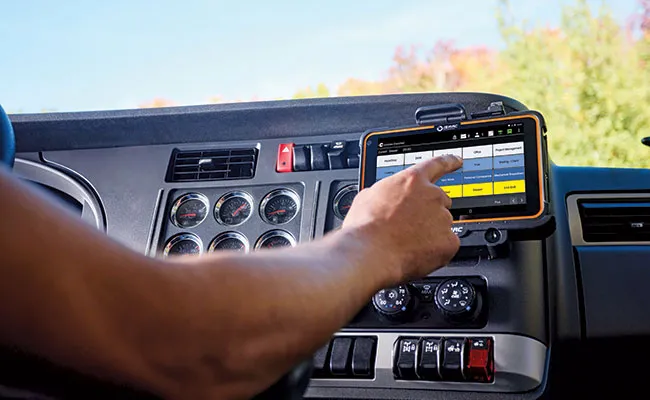
In-cab telematics systems typically perform a variety of functions, from fleet tracking and regulatory compliance to driver coaching and onboard video. (Isaac Instruments)
Vehicle maintenance is another use case for AI and machine learning.
Using AI to scrutinize engine data — diagnostics or trouble codes — to discover a pattern can yield a prediction that, for example, a water pump is likely to fail within one week, said Elsner of Pedigree Technologies.
Elsner said he visited a fleet customer that had reduced breakdowns by using such predictive maintenance, but driver and manufacturer acceptance of the predictions is proving to be a hurdle. The fleet found that drivers were reluctant to pull over when the malfunction light on the dashboard wasn’t illuminated, he said, and truck dealers tended to be averse to approving replacement of a working component that was still under warranty.
For now, some tech vendors are waiting for AI to mature further before leaning in fully.
“We do [human] review-auditing of video,” Solera’s Gardner said. “We can audit, over time, the efficacy of AI to ensure that it’s meeting our customers’ expectations.”
Want more news? Listen to today's daily briefing below or go here for more info:





